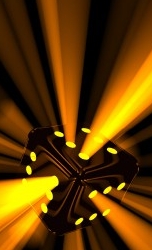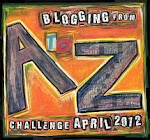E Is for Exploding Dice
Since I’m a guy, I like it when things explode. Cars that fly off cliffs, buildings full of bad guys, vampires exposed to sunlight, et cetera. Of course, these things are most fun when they’re not real. I don’t like it when real people are inside exploding cars, and even bad guys and vampires deserve something resembling due process. (Well, maybe not vampires, especially the sparkly kind.)
In game terms, an exploding die is a die that when rolled and yielding a certain, predefined result, is then rerolled, and the various results are totaled to give one uber-result. For example, if a d6 explodes on a 6, and I roll a 6, I roll the die again, and add that result to the 6. If I roll another 6, the die explodes again, and so on. Many game systems incorporate exploding dice. Torg had them. AD&D had them for Forgotten Realms firearms damage. Savage Worlds makes extensive use of exploding dice. I think Pathfinder should use them also, so let’s spitball what that might look like.
Ability Scores: Primary, Secondary, & Tertiary
First, let’s borrow a concept I discovered in Go Fer Yer Gun! by Beyond Belief Games. A PC’s ability scores are divided equally into three groups: primary, second, and tertiary. The player chooses which abilities are which at character creation. Once these choices are made, they cannot be altered.
Wes is making up Torina, a new paladin. Wes assigns Torina’s stats this way:

Primary – Strength, Charisma
Secondary – Dexterity, Wisdom
Tertiary – Constitution, Intelligence
An ability score’s type determines which exploding die the player gets to roll whenever the PC makes an ability check or skill check for that ability score.
Primary Ability Score Exploding Die – 1d8, explodes on an 8
Secondary Ability Score Exploding Die – 1d6, explodes on a 6
Tertiary Ability Score Exploding Die – 1d4, explodes on a 4
Saving Throws
A PC’s saving throws get an exploding die as well, based on whether it is a good save or a poor save. To continue with our example, Torina has two good saves, Fortitude and Will, and one poor save, Reflex.
Good Save Exploding Die – 1d6, explodes on a 6
Poor Save Exploding Die – 1d4, explodes on a 4
Attack Rolls
Unsurprisingly, a PC’s attack rolls also enjoy an exploding die, depending on whether the PC’s Base Attack Bonus uses fast, medium, or slow progression. Considering our examplar Torina again, as a paladin she uses the fast BAB exploding die.
Fast BAB Exploding Die – 1d8, explodes on an 8
Medium BAB Exploding Die – 1d6, explodes on a 6
Slow BAB Exploding Die – 1d4, explodes on a 4
Multi-Class Characters
Multi-classing doesn’t affect which exploding dice a character uses. Rather, the types of exploding dice are locked in at 1st-level. Therefore, if Torina later picks up a level in rogue, she doesn’t get to use the Good Save Exploding Die for Reflex.
Using Exploding Dice
Whenever a player makes a d20 roll for an ability check, skill check, saving throw, or attack roll, he also rolls the appropriate exploding die. The result of the exploding die is added to the d20 roll, and this total determines success. Please consider these examples:
* Torina must convince a city guard to let her pass into a restricted area. She makes a Diplomacy check aided by a d8 exploding die because Charisma is one of Torina’s primary ability scores.
* Later, the assassin Torina has been tracking hits Torina with a lightning bolt. A d4 exploding die aids her Reflex save.
* Torina survives the lightning bolt and smites the assassin. She adds a d8 exploding die to her attack roll.
Other Considerations
If you use exploding dice, remove most of the Big Six magic items from play. The Big Six magic items are armor and shield, magic weapon, natural armor item, deflection bonus item, resistance item, and stat boosters. Get rid of those Big Six items that do not modify Armor Class. The exploding dice provide automatic (albeit variable) modifiers to attack rolls, saving throws, ability checks, and skill checks, which are the main things the Big Six boost other than AC. This will perhaps put a dent in spellcaster save DCs over time, but this can be remedied by adding items that specifically boost a caster’s save DC without boosting the caster’s ability scores. Thus, a wizard can’t have a headband of intellect +4, but he could perhaps have a headband of spell power +2 that would increase the DCs to save against his spells.
When considering magic weapons, simply ignore enhancement bonuses that directly affect attack rolls and damage. Furthermore, waive the requirement that a magic weapon cannot have a special ability without having at least a minimum enchancement bonus of +1. This way, a character can have a flaming longsword that does +1d6 points of fire damage, but that sword would not have a static enhancement bonus as well.
Also, the attack roll exploding die has a special effect. For every four points a d20 + exploding die attack roll exceeds the target’s AC, increase the damage from that attack by +1. This bonus gets multiplied on critical hits. Back to Torina smiting the assassin. Let’s say Torina needs an 18 to hit. She rolls 1d20 + 1d8. She gets a 15 on the d20, and rolls an 8 on her exploding die. She rolls again for another 5. She adds her Strength bonus and BAB for a total attack roll of 32, which exceeds the assassin’s AC by 14 points. This is enough to earn Torina a +3 bonus to her damage.
Lastly, if you use Hero Points as described in the Advanced Player’s Guide, consider modifying them so that a Hero Point grants an extra exploding die of the same type that would be rolled. If Torina really wants to nail that assassin, she could spend a Hero Point and roll 1d20 + 2d8, with both d8s being exploding dice.


Leave a Reply